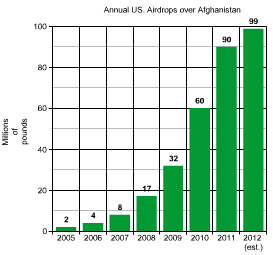
Source / U.S. Air Force
As the Taliban — or somebody — was assassinating former Afghan president Burhanuddin Rabbani in Kabul on Tuesday, a top U.S. Air Force general was explaining what he called “an amazing success story” in that war-torn land. But one needs to be careful in drawing lessons from such successes. Especially given the fact that it evidently was the Taliban who killed Rabbani, whose post-presidential job…was leading fitful peace talks…with the Taliban.
Anyway, General Ray Johns explained how much more the U.S. is now relying on airdrops to supply U.S. troops sprinkled across Afghanistan. As you can see in the chart, they’ve grown from 2 million pounds in 2005 to an anticipated 99 million pounds next year. “We’re dropping about 6,000 four-foot-by-four-foot bundles a month…basically food, water ammo and fuel,” John said. “It’s quite an amazing success story.”
Tactically, maybe. Strategically, not so much.
An Army report released Tuesday also had numbers moving in the wrong direction: amputations among U.S. troops, almost all wounded in Afghanistan, jumped from 86 in 2009, to 187 in 2010; 147 have suffered an amputation so far this year. U.S. troops suffering multiple amputations climbed from 23 in 2009, to 72 in 2010, and 77 so far this year. The military argues in both cases that a more aggressive U.S. approach in fighting the Taliban — along with 30,000 extra troops in the country — have contributed to the growth in both categories.
When Battleland asked the general why airdrops have exploded 50-fold in recent years, he spoke planely. U.S. troops “are in places where getting them their supplies is very risky to go by land conveyance — IEDs and snipers — so they become more and more dependent on our airdrop” from C-17s and C-130s. “I can airdrop it in and get them what they need, and let them focus on their mission…if they come into contact [with the enemy] I can give them food, water, ammo and help them survive that contact until we call in close air support.”
But if so much of Afghanistan is so dangerous for U.S. ground convoys, how does that square with the notion that the U.S. and its allies are prevailing there? “I would love to have all the military convoys gone, because that’s risky to our soldiers, sailors, airmen and Marines,” Johns says. “I love doing it by airdrop because I can meet the needs and I can save lives.”
We get it. Airlifters should be proud of what they do and how well they do it. But if we’re winning in Afghanistan, shouldn’t the number of airdrops be falling as more and more Afghan terrain is safe for ground convoys? “You’re exactly right,” Johns said. “But at the end of the day, I want to make sure I get them what they need.”


